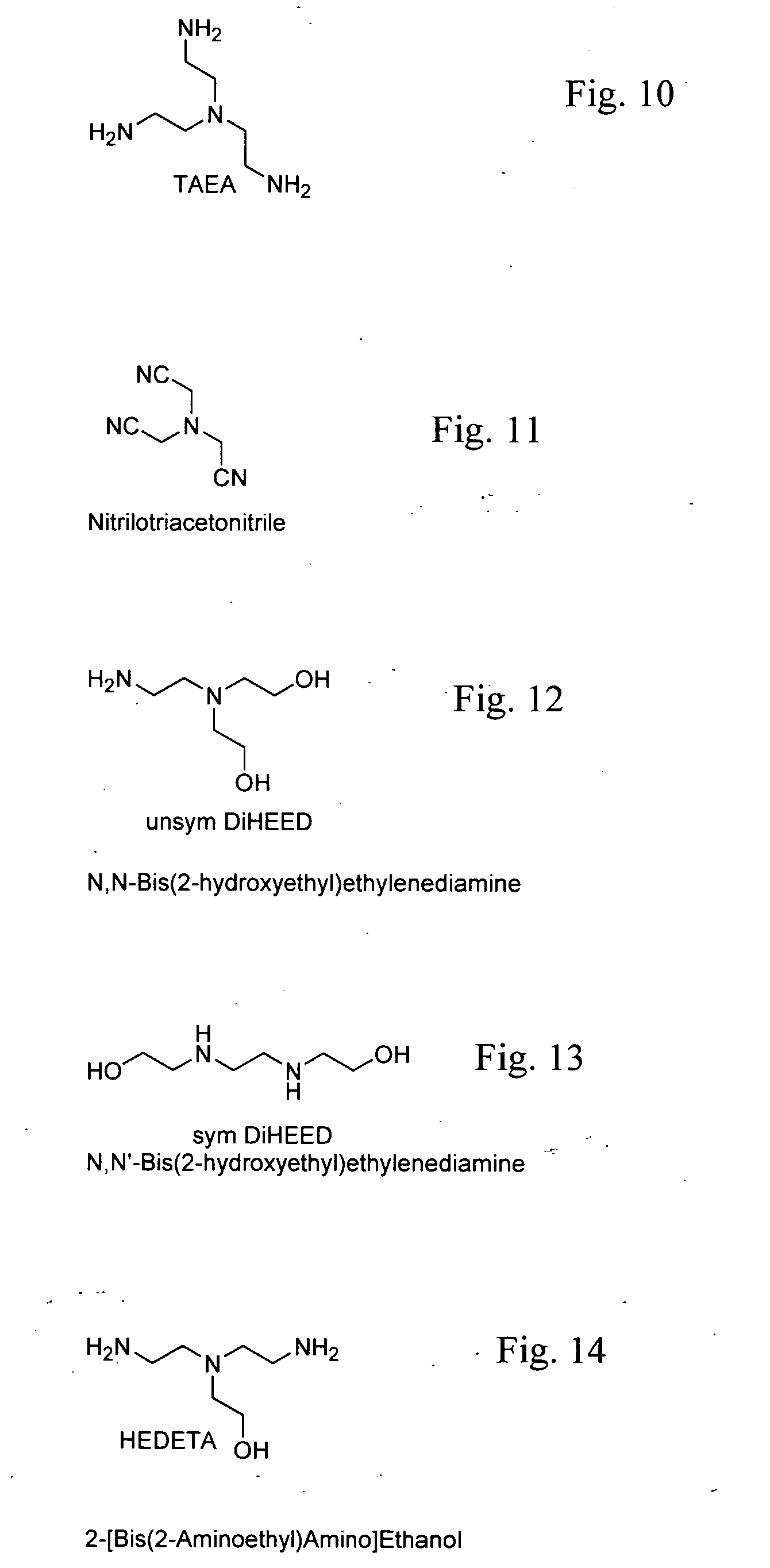Methods of making cyclic, N-amino functional triamines
- Summary
- Abstract
- Description
- Claims
- Application Information
AI Technical Summary
Benefits of technology
Problems solved by technology
Method used
Image
Examples
example 1
[0117]A catalyst was prepared by an incipient wetness technique using two impregnations. A solution of 107.6 grams of nickel nitrate hexahydrate (Aldrich no. 244074; crystal, 98%) and 8.26 grams of ammonium perrhenate (Molymet) in 318 ml deionized water was prepared. The solution was heated to 70° C. 193 ml of the solution was added to 297.0 grams of a pre-dried alumina / silica carrier (Al2O3 / SiO2, 80:20, 1 / 16″ extrudate, SA=153 m2 / g), followed by calcination in air at 340° C. for 2 hours. A second impregnation using the remaining solution (188 ml) was followed by calcination at 340° C. for 3 hours. The catalyst was reduced at 340° C. in flowing hydrogen at a flow rate of −1600 cc / min for three hours. Following the reduction, the catalyst was allowed to cool to room temperature and passivated using 1% oxygen in nitrogen to allow handling in air. The final yield was 325.5 grams of catalyst with a nominal composition of 6.8 wt. % nickel and 1.8 wt. % rhenium on alumina-silica.
[0118]The...
example 2
[0120]Various materials were also evaluated in a batch mode as reported in this and the ensuing examples unless otherwise expressly noted. The reactions were conducted in a 2 L high-pressure 316SS autoclave (Autoclave Engineers) equipped with a magnetic stirrer, a dip tube for sampling, and a catalyst basket. Catalyst of Example 1 was charged to the catalyst basket and activated overnight with flowing hydrogen at 180° C. The autoclave was cooled to room temperature, and the liquid reactants charged by pressure, followed by ammonia (optional), taking care not to admit air. The autoclave was brought to operating pressure with hydrogen, and heated to operating temperature with stirring. Pressure was adjusted during the run, if necessary, by bleeding off or adding hydrogen to the autoclave. Samples were taken hourly via the dip tube and analyzed by GC. Prior to analysis, ammonia (if present) was weathered off.
[0121]Table 1 gives the results from reacting 900 grams of EDA with 100 grams ...
example 3
[0122]Table 2 gives the results from reacting 844 grams of EDA with 100 grams of a commercial nickel on silica / alumina catalyst at 145-158° C. and an initial hydrogen pressure of 270 psig but otherwise using the procedures of Example 2. The pressure of the reactor during the run was 800 to 1135 psig. As can be seen from the table, AEP increases with EDA conversion. These conditions produced less AEP at a given. EDA conversion than those in Table 1 above.
TABLE 2Catalyst: Sud-Chemie C46-7-03, 50% Ni on silica / aluminaRun no.123456Time, hrs123456Temp, ° C.156152154145147158GC resultsEDA91.9180.9677.0270.9763.5154.66PIP0.291.271.933.205.469.09DETA7.2415.3417.6720.6723.4725.10AEP0.010.070.110.210.491.07I-TETA0.401.722.343.454.826.37PEEDA0.010.020.030.070.170.44I-TEPA0.090.530.761.201.622.30OTHER0.060.100.130.220.460.98AMINES~EDA9.4621.8426.2032.8040.7549.87Conversion, %Wt % inProduct(EDA free)PIP3.536.658.3811.0114.9720.05DETA89.4680.5776.9171.2264.3355.37AEP0.100.350.480.731.342.36I-TETA...
PUM
| Property | Measurement | Unit |
|---|---|---|
| Temperature | aaaaa | aaaaa |
| Temperature | aaaaa | aaaaa |
| Temperature | aaaaa | aaaaa |
Abstract
Description
Claims
Application Information
 Login to View More
Login to View More - R&D
- Intellectual Property
- Life Sciences
- Materials
- Tech Scout
- Unparalleled Data Quality
- Higher Quality Content
- 60% Fewer Hallucinations
Browse by: Latest US Patents, China's latest patents, Technical Efficacy Thesaurus, Application Domain, Technology Topic, Popular Technical Reports.
© 2025 PatSnap. All rights reserved.Legal|Privacy policy|Modern Slavery Act Transparency Statement|Sitemap|About US| Contact US: help@patsnap.com



